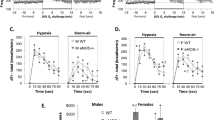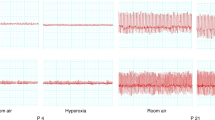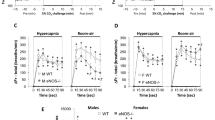Abstract
BACKGROUND: Ventilation in response to hypoxia is reduced in some obese humans and is believed to represent part of the pathogenesis of obesity hypoventilation syndrome (OHS). Ventilation in response to hypoxic exposure is closely related to the release of excitatory neurotransmitters, in particular glutamate, acting specifically on N-methyl-D-aspartate (NMDA) receptors.
OBJECTIVES: The aim of the present study was to investigate whether NMDA receptor-mediated mechanisms are responsible for the altered ventilatory response to sustained hypoxia observed in obese Zucker (Z) rats.
SUBJECTS: Seven lean and seven 15-week-old obese male Z rats were studied.
MEASUREMENTS: Ventilation (V̇E) at rest and during 30 min sustained hypoxic (10% O2) exposure was measured by the barometric method. V̇E was assessed following the blinded-random administration of equal volumes of either saline (vehicle) or dextromethorphan (DM, 10 mg/kg), a non-competitive glutamate NMDA receptor antagonist.
RESULTS: DM had no effects on resting V̇E in both lean and obese rats during room air breathing. Lean rats treated with DM exhibited a significant (P<0.05) depression in V̇E, VT, and VT/TI during either the early (5 min) or the late phase (30 min) of ventilatory response to sustained hypoxia. In contrast, DM administration in obese rats did not change V̇E, VT, or VT/TI during the early phase of ventilatory response to hypoxia. During the late phase of ventilatory response to hypoxia. obese rats treated with DM exhibited a similar depression in V̇E and VT as observed in lean rats, but had no significant change in VT/TI during the 30 min hypoxic exposure.
CONCLUSION: Our findings indicate that altered glutamatergic mechanisms acting on NMDA receptors are partially responsible for a blunted early phase of ventilatory response to hypoxia noted in obese rats and also contribute to their reduced neural respiratory drive.
This is a preview of subscription content, access via your institution
Access options
Subscribe to this journal
Receive 12 print issues and online access
$259.00 per year
only $21.58 per issue
Buy this article
- Purchase on Springer Link
- Instant access to full article PDF
Prices may be subject to local taxes which are calculated during checkout



Similar content being viewed by others
References
Rochester DF . Obesity and pulmonary function. In: Alpert MA, Alexander JK (eds). The heart and lung in obesity Futura Armonk: NY 1998 109–131.
Babb TG . Mechanical ventilatory constraints in aging, lung disease, and obesity: perspectives and brief review Med Sci Sports Exerc 1999 31 (Suppl): S12–S22.
Farkas GA, Schlenker EH . Pulmonary ventilation and mechanics in morbidly obese Zucker rats Am J Respir Crit Care Med 1994 150: 356–362.
Schlenker EH, Farkas GA . Endogenous opioids modulate ventilation in the obese Zucker rat Respir Physiol 1995 99: 97–103.
Lee SD, Nakano H, Gosselin LE, Krasney JA, Schlenker EH, Farkas GA . Endogenous opioids modulate ventilation and peak oxygen consumption in obese Zucker rats Am J Resp Crit Care Med 2000 162: 1009–1015.
Lee SD, Nakano H, Farkas GA . GABAergic modulation of ventilation in obese Zucker rats J Appl Physiol 2001 (in press)
Nakano H, Magalang UJ, Lee SD, Krasney JA, Farkas GA . Serotonergic modulation of ventilation and upper airway stability in obese Zucker rats Am J Respir Crit Care Med 2001 (in press)
Morgan EJ, Zwillich CW . The obesity-hypoventilation syndrome West J Med 1978 129: 387–393.
Zwillich CW, Sutton FD, Pierson DJ, Greagh EM, Weil JV . Decreased hypoxic ventilatory drive in the obesity-hypoventilation syndrome Am J Med 1975 59: 343–348.
Easton PA, Slykerman LJ, Anthonisen NR . Ventilatory response to sustained hypoxia in normal adults J Appl Physiol 1986 61: 906–911.
Lin J, Suguihara C, Huang J, Hehre D, Devia C, Bancalari E . Effect of N-methyl-D-aspartate-receptor blockade on hypoxic ventilatory response in unanesthetized piglets J Appl Physiol 1996 80: 1759–1763.
Ang RC, Hoop B, Kazemi H . Role of glutamate as the central neurotransmitter in the hypoxic ventilatory response J Appl Physiol 1992 72: 1480–1487.
Mizusawa A, Ogawa H, Kikuchi Y, Hida W, Kurosawa H, Okabe S, Takishima T, Shirato K . In vivo release of glutamate in nucleus tractus solitarii of the rat during hypoxia J Physiol 1994 478: 55–66.
Kazemi H, Hoop B . Glutamic acid and γ-aminobutyric acid neurotransmitters in central control of breathing J Appl Physiol 1991 70: 1–7.
Richter DW, Schmidt-Garcon P, Pierrefiche O, Bischoff AM, Lalley PM . Neurotransmitters and neuromodulators controlling the hypoxic respiratory response in anaesthetized cats J Physiol 1999 514: 567–578.
Church J, Sawyer D, McLaron JG . Interactions of dextromethorphan with the N-methyl-D-aspartate receptor-channel complex: single channel recordings Brain Res 1994 666: 189–194.
Cole AE, Eccles CU, Aryanpur JJ, Fisher RS . Selective depression of N-methyl-D-aspartate-mediated responses by dextrorphan in hippocampal slice in rat Neuropharmacology 1989 28: 249–254.
Maskrey M, Megirian D, Farkas GA . Effect of changing body temperature on the ventilatory and metabolic responses of lean and obese Zucker rats Am J Physiol 1998 275: R531–540.
Drorbaugh JE, Fenn WO . A barometric method for measuring ventilation in newborn infants Pediatrics 1955 16: 81–86.
Jacky JP . Barometric measurement of tidal volume: effects of pattern and nasal temperature J Appl Physiol 1980 49: 319–325.
Frappel P, Lautier C, Baudinette RV, Mortola JP . Metabolism and ventilation in acute hypoxia: a comparative analysis in small mammalian species Am J Physiol 1992 262: R1040–R1046.
Refinetti R . Computation of the body mass for metabolic studies of lean and obese rats Metabolism 1989 38: 763–766.
Wu D, Otton SV, Kalow W, Sellers EM . Effects of route of administration on dextromethorphan pharmacokinetics and behavioral response in the rat J Pharmac Exp Ther 1995 274: 1431–1437.
Soto-Arape I, Burton MD, Kazemi H . Central amino acid neurotransmitters and the hypoxic ventilatory response Am J Respir Crit Care Med 1995 151: 1113–1120.
Bonham AC . Neurotransmitters in the CNS control of breathing Respir Physiol 1995 101: 219–230.
Bianchi AL, Denavit-Saubiè M . Champagnat J. Central control of breathing in mammals: neuronal circuitry, membrane properties, and neurotransmitters Physiol Rev 1995 75: 1–45.
Ogawa H, Mizusawa A, Kikuchi Y, Hida W, Miki H, Shirato K . Nitric oxide as a retrograde messenger in the nucleus tractus solitarii of rats during hypoxia J Physiol 1995 486: 495–504.
Loscher W, Honack D . The behavioural effects of MK-801 in rats: involvement of dopaminergic, serotonergic and noradrenergic systems Eur J Pharmac 1992 215: 199–208.
Vanover KE . Interaction of ethanol with excitatory amino acid receptor antagonists in mice Eur J Pharmac 1999 368: 137–142.
Albers GW, Atkinson RP, Kelley RE, Rosenbaum DM . Safety, tolerability and pharmacokinetics of N-methyl-D-aspartate antagonist dextrorphan in patients with acute stroke Stroke 1995 26: 254–258.
Schlenker EH . Dextromethorphan affects ventilation differently in male and female rats J Appl Physiol 1996 81: 1911–1916.
Cannoll PD, Smith PR, Gottesman S, Musacchio JM . Autoradiographic localization of [3H] dextromethorphan in guinea pig brain: allosteric enhancement by ropizine J Neurosci Res 1989 24: 311–328.
Acknowledgements
The present study was supported by research grant no. AG-16048 from the National Institutes of Health. GA Farkas is the recipient of a Career Investigator Award from the American Thoracic Society
Author information
Authors and Affiliations
Corresponding author
Rights and permissions
About this article
Cite this article
Lee, S., Nakano, H. & Farkas, G. NMDA receptor-mediated modulation of ventilation in obese Zucker rats. Int J Obes 25, 997–1004 (2001). https://doi.org/10.1038/sj.ijo.0801663
Received:
Revised:
Accepted:
Published:
Issue Date:
DOI: https://doi.org/10.1038/sj.ijo.0801663
Keywords
This article is cited by
-
Altered nitroxidergic and NMDA receptor-mediated modulation of baroreflex-mediated heart rate in obese Zucker rats
Hypertension Research (2010)
-
Altered insulin-mediated and insulin-like growth factor-1-mediated vasorelaxation in aortas of obese Zucker rats
International Journal of Obesity (2007)
-
Cardiac Fas Receptor‐dependent Apoptotic Pathway in Obese Zucker Rats
Obesity (2007)
-
More Activated Cardiac Mitochondrial‐dependent Apoptotic Pathway in Obese Zucker Rats
Obesity (2007)
-
Adenosinergic Modulation of Ventilation in Obese Zucker Rats
Obesity Research (2005)



